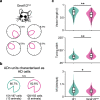Flexible cue anchoring strategies enable stable head direction coding in both sighted and blind animals
- PMID: 36123333
- PMCID: PMC9485117
- DOI: 10.1038/s41467-022-33204-0
Flexible cue anchoring strategies enable stable head direction coding in both sighted and blind animals
Abstract
Vision plays a crucial role in instructing the brain's spatial navigation systems. However, little is known about how vision loss affects the neuronal encoding of spatial information. Here, recording from head direction (HD) cells in the anterior dorsal nucleus of the thalamus in mice, we find stable and robust HD tuning in rd1 mice, a model of photoreceptor degeneration, that go blind by approximately one month of age. In contrast, placing sighted animals in darkness significantly impairs HD cell tuning. We find that blind mice use olfactory cues to maintain stable HD tuning and that prior visual experience leads to refined HD cell tuning in blind rd1 adult mice compared to congenitally blind animals. Finally, in the absence of both visual and olfactory cues, the HD attractor network remains intact but the preferred firing direction of HD cells drifts over time. These findings demonstrate flexibility in how the brain uses diverse sensory information to generate a stable directional representation of space.
© 2022. The Author(s).
Conflict of interest statement
The authors declare no competing interests.
Figures







References
-
- Klatzky, R. L. Allocentric and Egocentric Spatial Representations: Definitions, Distinctions, and Interconnections. in Spatial Cognition: An Interdisciplinary Approach to Representing and Processing Spatial Knowledge (eds. Freksa, C., Habel, C. & Wender, K. F.) 1–17 (Springer, 1998).
Publication types
MeSH terms
Grants and funding
LinkOut - more resources
Full Text Sources
Molecular Biology Databases

